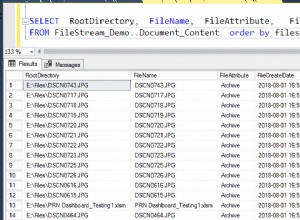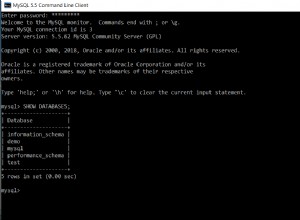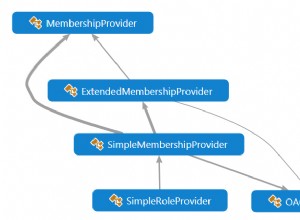Esistono diversi modi per trasformare i dati. Alcuni usano una funzione di aggregazione e altri no. Ma anche se stai ruotando una stringa, puoi comunque applicare un aggregato.
Aggiungere con CASE:
select name,
max(case when category = 'A' then 'X' else '' end) CategoryA,
max(case when category = 'B' then 'X' else '' end) CategoryB,
max(case when category = 'C' then 'X' else '' end) CategoryC,
max(case when category = 'D' then 'X' else '' end) CategoryD
from yourtable
group by name
Vedi SQL Fiddle con demo
Pivot statico:
Puoi ancora usare il PIVOT funzione per trasformare i dati anche se i valori sono stringhe. Se disponi di un numero noto di categorie, puoi codificare la query:
select name,
coalesce(A, '') CategoryA,
coalesce(B, '') CategoryB,
coalesce(C, '') CategoryC,
coalesce(C, '') CategoryD
from
(
select name, category, 'X' flag
from yourtable
) d
pivot
(
max(flag)
for category in (A, B, C, D)
) piv
Vedi SQL Fiddle con demo .
Pivot dinamico:
Se hai un numero sconosciuto di categorie, puoi utilizzare SQL dinamico:
DECLARE @cols AS NVARCHAR(MAX),
@colsNull AS NVARCHAR(MAX),
@query AS NVARCHAR(MAX)
select @cols = STUFF((SELECT ',' + QUOTENAME(category)
from yourtable
group by category
order by category
FOR XML PATH(''), TYPE
).value('.', 'NVARCHAR(MAX)')
,1,1,'')
select @colsNull = STUFF((SELECT ', coalesce(' + QUOTENAME(category)+', '''') as '+QUOTENAME('Category'+category)
from yourtable
group by category
order by category
FOR XML PATH(''), TYPE
).value('.', 'NVARCHAR(MAX)')
,1,1,'')
set @query = 'SELECT name, ' + @colsNull + '
from
(
select name, category, ''X'' flag
from yourtable
) x
pivot
(
max(flag)
for category in (' + @cols + ')
) p '
execute(@query)
Vedi SQL Fiddle con demo .
Più join:
select c1.name,
case when c1.category is not null then 'X' else '' end as CategoryA,
case when c2.category is not null then 'X' else '' end as CategoryB,
case when c3.category is not null then 'X' else '' end as CategoryC,
case when c4.category is not null then 'X' else '' end as CategoryD
from yourtable c1
left join yourtable c2
on c1.name = c2.name
and c2.category = 'B'
left join yourtable c3
on c1.name = c3.name
and c3.category = 'C'
left join yourtable c4
on c1.name = c4.name
and c4.category = 'D'
where c1.category = 'A'
Vedi SQL Fiddle con demo
Tutte le query daranno il risultato:
| NAME | CATEGORYA | CATEGORYB | CATEGORYC | CATEGORYD |
--------------------------------------------------------
| Joe | X | X | | X |
| Mary | X | | X | X |




